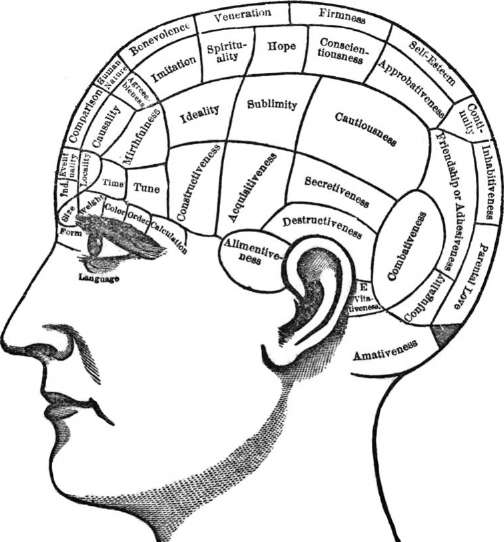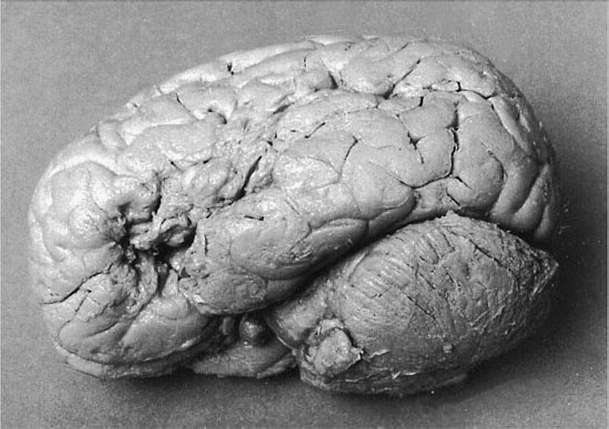Connectome (4 page)
Authors: Sebastian Seung

Most of the surface of the cerebrum is covered by a sheet of tissue just a few millimeters thick. This is known as the
cerebral cortex,
or cortex for short. Spanning the area of a hand towel, the cortex can fit inside the skull only because it's folded up. The folds give the cerebrum a wrinkled appearance. The most obvious boundary within the cortex is visible from above: a large groove running from front to back (see Figure 8, left). This groove, called the longitudinal fissure, divides the left and right hemispheres of the cerebrum, the “left brain” and “right brain” of pop psychology.
It's less obvious how to subdivide each cerebral hemisphere, but one reasonable approach relies again on grooves of the cortex. After the longitudinal fissure, the next most prominent groove is called the Sylvian fissure (see Figure 8, right). After that is the central sulcus, which runs vertically from the Sylvian fissure toward the top of the brain. These two major grooves divide each hemisphere into four lobes
: frontal, parietal, occipital, and temporal. (By the way, it's worth memorizing the names and locations of these lobes, as I will refer to them often.)
Â
 Â
Â
Â
Â
Figure 8. The cerebrum divided into hemispheres
(left),
and each hemisphere divided into lobes
(right)
Â
There are many other, more minor grooves on the brain's surface, some of which are in roughly the same location from person to person. These have names and are still used today as landmarks. But does dividing the cortex along its grooves really make sense? Are they genuine boundaries, or merely an insignificant byproduct of the fact that the cortex has to fold to fit inside the skull?
The problem of dividing the cortex was first confronted in the nineteenth century. Before then, it was thought that the cortex merely served to cover the rest of the brain. (The term
cortex
is derived from the Latin word meaning “bark,” as in tree bark.) In 1819 the German physician Franz Joseph Gall published his theory of “organology.” He noted that every organ of the body serves a distinct function: the stomach for digestion, the lungs for breathing, and so on. Gall argued that the brain is too complex to be a single organ, and the mind too complex to be a single function. He proposed to divide both. In particular, he recognized the importance of the cortex and divided it into a set of regions, which he called the “organs” of the mind.
Gall's disciple Johann Spurzheim later introduced the term
phrenology,
more familiar to us than Gall's original name for the theory. The phrenological map shown in Figure 9 displays regions corresponding to functions with names like “acquisitiveness,” “firmness,” and “ideality.” These particular correspondences are now considered fanciful imaginings based on flimsy evidence, but the phrenologists eventually turned out to be more right than wrong. Their emphasis on the cortex is widely accepted today, and their approach of localizing mental functions to particular cortical regions is still taken seriously. It now goes by the name of cortical or cerebral
localizationism.
Â
 Â
Â
Â
Figure 9. Phrenological map
Â
The first real evidence for localization came later in the nineteenth century from observations of patients with brain damage. At that time, many French neurologists worked at two Parisian hospitals. Salpêtrière, on the Left Bank of the Seine River, housed female patients; male patients were placed farther from the city center, in Bicêtre. Both hospitals were founded in the seventeenth century and had functioned as prisons and mental asylums
too. (The distinction was blurred by Bicêtre's most famous inmate, the Marquis de Sade.) Both hospitals had pioneered humane methods for the treatment of the insane, such as not confining them in chains.
I imagine that they remained depressing places all the same.
In 1861 the French physician Paul Broca was called to examine a fifty-one-year-old patient suffering from an infection in his surgical ward at Bicêtre. According to the records, the patient had been incarcerated since the age of thirty. At the time of admission he had already lost the ability to speak any word except the monosyllable “tan,” which became his nickname. Since Tan could communicate with hand gestures, it seemed that he could comprehend language, although he could not speak it.
A few days after the examination, Tan succumbed to his infection, and Broca performed an autopsy. He sawed open the skull, removed the brain, and placed it in alcohol for preservation. The most prominent damage to Tan's brainâsee Figure 10
âwas a large cavity in the left frontal lobe.
Â
 Â
Â
Â
Figure 10. Tan's brain, with damage to Broca's region
Â
Broca announced his discovery to the Anthropological Society the next day. He claimed that the damaged region in Tan's brain was the source of speech, which was distinct from comprehension. Today, loss of language ability is known as
aphasia.
Loss of speech, in particular, is called Broca's aphasia, and the damaged location in Tan's cerebral cortex is known as Broca's region. With his discovery, Broca managed to settle a debate that had raged for decades. The phrenologist Gall had asserted at the beginning of the nineteenth century that linguistic functions were located in the frontal lobe of the brain, but had been met with skepticism. Broca finally provided some convincing evidence, as well as a specific location in the frontal lobe.
As time went on, Broca encountered more cases similar to Tan's and found that they all involved damage to the left hemisphere of the brain. Given that the two hemispheres looked so similar
to each other, it was hard to believe that they could be different in their functions. But the evidence mounted, and Broca concluded in an 1865 paper that the left hemisphere was specialized or dominant for language.
Subsequent researchers have confirmed that this is the case for almost all people. Thus Broca's findings supported not only cortical localization but also
cerebral lateralization
, the idea that mental functions are located in either the left or the right hemisphere.
In 1874 the German neurologist Carl Wernicke described a different kind of aphasia. Unlike Tan, his patient could speak words fluently, but the sentences didn't make sense. Furthermore, the patient could not comprehend questions asked of him. Autopsy showed damage to part of the temporal lobe of the left hemisphere. Wernicke concluded that loss of comprehension was the primary effect of damage to this region. Production of nonsensical sentences was a secondary effect, which could have arisen because a person may need to comprehend what he or she is saying in order to say something that makes sense. The symptoms caused by damage to Wernicke's region are known today as Wernicke's aphasia.
Together, Broca and Wernicke provided a
double dissociation
of speech production and comprehension. Damage to Broca's region halted production of words but left comprehension intact; damage to Wernicke's region destroyed comprehension but spared production. This was important evidence that the mind is “modular.” It might seem obvious that language is distinct from other mental abilities, since it is possessed by humans but not other animals, but it's less obviousâor
was
less obvious, before Broca and Wernickeâthat language can be further subdivided into separate modules for production and comprehension.
Broca and Wernicke showed how to map the cortex by relating the symptoms of patients to the locations of brain lesions. By using this method, their successors were able to identify the functions of many other regions of the cortex. They created maps resembling those of the phrenologists, but based on solid data. Could their findings on cortical localization be used to understand mental differences?
Â
When Albert Einstein died in 1955, his body was cremated. His brain was not, because it had been removed by the pathologist Thomas Harvey during an autopsy. Fired from Princeton Hospital a few months later, Harvey kept Einstein's brain. Over the following decades he carried 240 pieces with him in a jar as he moved from city to city. In the 1980s and 1990s, Harvey sent specimens
to several researchers who shared his goal of finding out what was special about the brain of a genius.
Harvey had already determined that the weight of Einstein's brain was average, or even slightly below average; thus brain size couldn't explain why Einstein was extraordinary. Sandra Witelson
and her collaborators proposed another explanation in 1999. They argued, based on the photographs Harvey had taken during the autopsy, that a cortical region called the inferior parietal lobule was enlarged. (This region is part of the parietal lobe of the brain.) Perhaps Einstein was a genius because
part
of his brain was enlarged. Einstein himself reported that he often thought in images rather than words, and the parietal lobe of the brain is known to be involved in visual and spatial thinking.
Anatole France and Albert Einstein belong to a long tradition of public fascination with geniuses' brains. Nineteenth-century enthusiasts preserved the brains of luminaries
like the poets Lord Byron and Walt Whitman, which still sit today in dusty jars relegated to the back rooms of museums. I find it strangely heartening that Tan and Paul Broca, the wordless patient and the neurologist who studied him, are now companions for eternity, as the same Parisian museum preserves both of their brains. Neuroanatomists also preserved the brain of Carl Gauss, one of the greatest mathematicians of all time. They pointed to an enlarged parietal lobe to explain his genius, anticipating Witelson's explanation of Einstein's.
So the strategy of studying the sizes of specific brain regions rather than overall brain size is not new at all. In fact, it was originally invented by the phrenologists. Their founding father, Franz Joseph Gall, titled his 1819 treatise
The Anatomy and Physiology of the Nervous System in General, and of the Brain in Particular, with Observations upon the possibility of ascertaining the several Intellectual and Moral Dispositions of Man and Animal, by the configuration of their Heads.
Gall held that each mental “disposition” is correlated with the size of the corresponding cortical region. More dubiously, Gall argued that the shape of the skull reflected the shape of the underlying cortex and could be used to divine a person's dispositions. Phrenologists roamed the world offering to predict the fortunes of children, assess prospective marriage partners, and screen job applicants by feeling bumps on heads.
Gall and his disciple Spurzheim proposed functions for cortical regions based on anecdotes about extreme dispositions. If a genius had a large forehead, intelligence must be in the front of the brain. If a criminal's head bulged on the sides, the temporal lobe must be important for telling lies. Their anecdotal methods led to localizations that were mostly preposterous. By the second half of the nineteenth century, phrenology had become an object of ridicule.
